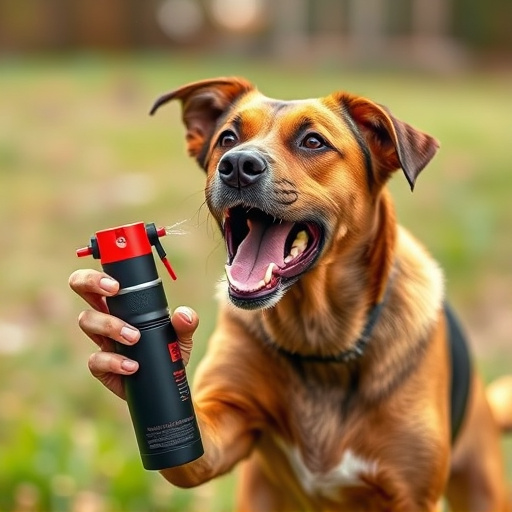The Mace Dog Repellent Spray uses capsaicin from chili peppers to deter aggressive dogs, creating a buffer zone of up to 4-6 feet. For optimal coverage, maintain a clear line of sight and target sensitive areas, holding the canister at arm's length. Regular practice ensures proficiency in preventing or managing dog attacks. While effective, these sprays vary among brands, and factors like wind direction can reduce coverage. Legal usage requires valid reasons and understanding local laws; misuse carries consequences.
“Self-defense against aggressive dogs is a vital skill, and understanding dog repellent sprays like Mace can be a game-changer. This comprehensive guide explores the effectiveness of active ingredients in these sprays, offering insights into optimal application techniques to ensure maximum Mace Dog Repellent Spray Coverage. We’ll also dispel common myths, highlight safety precautions, and navigate legal considerations for responsible ownership. By the end, you’ll be equipped with the knowledge to use this tool effectively and legally.”
- Understanding Dog Repellent Spray: Active Ingredients and Their Efficacy
- Proper Use and Application Techniques for Optimal Mace Dog Repellent Spray Coverage
- Common Misconceptions and Safety Precautions When Using Dog Spray
- Legal Considerations and Responsible Ownership in Relation to Dog Repellent Sprays
Understanding Dog Repellent Spray: Active Ingredients and Their Efficacy
Dog repellent sprays are designed to protect individuals from aggressive canine attacks, and understanding their active ingredients is key to assessing their effectiveness. These sprays typically contain capsaicin, a natural compound derived from chili peppers, which is known for its irritant properties. When sprayed into the eyes and nose of a dog, capsaicin triggers an intense irritation, causing the animal to retreat due to discomfort.
The coverage and potency of Mace Dog Repellent Spray, for instance, make it a popular choice. This type of spray can provide a defensive reach of up to 4-6 feet, allowing users to create a buffer zone against potential dog attacks. The active ingredient’s effectiveness is supported by its rapid action, creating a temporary yet powerful deterrent that can give individuals time to escape or seek assistance.
Proper Use and Application Techniques for Optimal Mace Dog Repellent Spray Coverage
For optimal Mace Dog Repellent Spray coverage, it’s crucial to understand and apply the correct techniques. Start by ensuring a clear line of sight to the approaching dog. Aim for the face and eyes, as these areas are highly sensitive, and the spray can quickly deter an attacker. Hold the canister at arm’s length, pointing it towards the target, and squeeze the trigger in short bursts. This method allows for precise application without wasting any of the powerful repellent.
Remember, timing is key; use the spray when the dog is within a few feet, as it needs to make direct contact with the animal’s mucous membranes. Practice these techniques in safe environments to become familiar with the spray’s range and effectiveness. Regular training will ensure you’re prepared if an encounter occurs, maximizing your chances of avoiding or de-escalating a potential attack while ensuring minimal harm to the dog if necessary.
Common Misconceptions and Safety Precautions When Using Dog Spray
When it comes to self-defense against dogs, many people reach for a spray as an easy solution. However, there are several misconceptions surrounding these products that can put users at risk if they’re not prepared. One common myth is that any dog spray will provide immediate and complete protection. The reality is that effectiveness varies greatly among brands, and factors like wind direction and animal behavior can drastically reduce the spray’s coverage area and impact. It’s crucial to understand that dog sprays are not one-size-fits-all; each product has specific instructions and recommended usage distances.
Safety precautions are paramount when handling any form of self-defense equipment, including Mace dog repellent sprays. Users should always read and follow the manufacturer’s guidelines carefully. This includes knowing the range of the spray and ensuring you’re within that distance when deploying it. Additionally, keeping the spray in an easily accessible location and practicing its use regularly can help ensure a quick response during an encounter. Remember, proper training and understanding of local laws regarding self-defense are just as important as the tool itself.
Legal Considerations and Responsible Ownership in Relation to Dog Repellent Sprays
In many jurisdictions, the use of dog repellent sprays is regulated by laws aimed at ensuring public safety and responsible pet ownership. These legal considerations vary across regions but generally require individuals carrying such sprays to have a valid reason and act in self-defense or that of others. Using dog repellent spray as a first resort or for any purpose other than deterring aggressive dogs can lead to legal repercussions, including fines or civil lawsuits.
Responsible dog ownership is paramount when considering the use of repellents like Mace Dog Repellent Spray. Owners should exhaust non-lethal methods of controlling their pets’ behavior before resorting to such measures. Additionally, understanding the spray’s coverage area and effectiveness is crucial; products like Mace offer a range of options designed for different scenarios and dog sizes. Knowing how to properly deploy these sprays ensures their efficacy while minimizing potential harm to both animals and humans.
In conclusion, understanding the active ingredients, proper application techniques, and safety precautions of a Mace Dog Repellent Spray is essential for effective self-defense against aggressive dogs. While legal considerations must be taken into account, responsible ownership includes being informed about these tools to protect oneself and others in appropriate situations. Maximizing spray coverage ensures its efficacy as a deterrent, making it a valuable addition to any personal safety toolkit.
